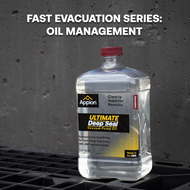Fast Evacuation Series: Oil Management
Jun 11th 2024
Fast Evacuation Series: Oil Management
Introduction
Vacuum pump oil is essential for a quick and efficient evacuation. Choosing the right oil and practicing proper oil management is paramount.
Functions of Vacuum Pump Oil
Vacuum pump oil serves four functions. It:
- Lubricates
- Cools the pump
- Captures contaminants
- Acts as a sealing component
This sealing ability is the vacuum pump oil's main and most important function. While the motor and vanes are spinning, the oil creates a film that helps seal all components. Most critically, it creates a vacuum-tight seal on the leading edge of the veins as moisture and contaminants are introduced to the oil. This seal will begin to degrade, but choosing the best oil will help maintain its integrity in a deep vacuum before degrading.
Choosing a Vacuum Pump Oil: Vapor Pressure
There are several factors to consider when choosing a vacuum pump oil. For the HVAC/R industry, the most important is vapor pressure. The vapor pressure of a vacuum pump oil is important because it dictates the ultimate vacuum a pump can achieve. Vacuum pump oil with a high vapor pressure will vaporize when exposed to a vacuum. The vaporized oil inhibits the pump’s sealing ability and raises the ultimate vacuum of the pump. Additionally, moisture and contaminants introduced into the oil during an evacuation will raise the vapor pressure of the oil. With this in mind, it's important to choose an oil with the lowest possible vapor pressure. Appion's Ultimate Deep Seal Vacuum Pump Oil has an ultra-low vapor pressure of less than one micron to maintain a strong seal and top performance in the deepest of vacuums.
Ultimate Deep Seal Vacuum Pump Oil - 1 Gallon, 1 Quart, 8 oz. Cartridge
Oil Quality and Condition
Along with oil quality, contamination of the oil directly affects how well the oil can perform these four functions. You should take note of the pump's oil condition during an evacuation to look for signs of contamination. Dark oil signifies that there are contaminants in the system from a lack of nitrogen during welding, degradation of the oil due to previous poor evacuation, or a compressor burnout. White milky oil signifies moisture in the system.
Contaminated, Clean, and Moist Vacuum Pump Oil
Monitoring Evacuation with a Vacuum Gauge
Oil contamination will be the greatest at the beginning of an evacuation, so it's important to change your oil early and as needed to avoid an unnecessarily slow evacuation. Vacuum pumps with a removable cartridge system lend themselves to easier oil monitoring and changes than conventional pumps. We also recommend using a high-accuracy vacuum gauge during your evacuation. This is another means of monitoring your oil condition. When the gauge begins to stall, you know it's time to change your oil. To achieve the fastest evacuation you must keep your oil clear and clean for as much of the evacuation as possible.
Oil Condition vs. Evacuation Speed
AV760 Full-Range Vacuum Gauge
TEZ8 Vacuum Pump
Conclusion
Now that you understand the importance of vacuum pump and oil management, we will walk you through setting up your evacuation to achieve full flow. Read more here.
Fast Evacuation Series // Part 3 - Oil Quality & Proper Oil Management Video:

